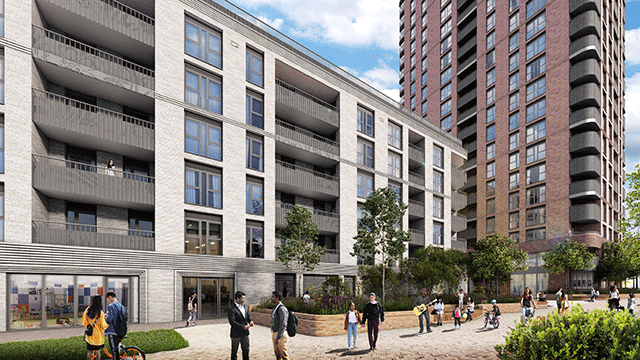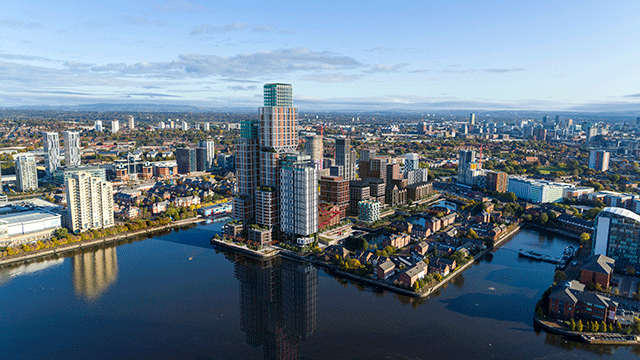Cain Hoy Enterprises and Galliard Homes’ plans for a £500m residential-led development at Peruvian Wharf, E16, have been put on hold by the Greater London Authority as it seeks to crack down on the conversion of industrial land to residential.
A total of 946 homes are proposed for the site, of which 35% would be affordable and 30% family-sized homes. An initial planning application was submitted in October for the site, which has been vacant and disused for more than 20 years despite its location next to a DLR station, West Silvertown. Cain Hoy and Galliard acquired the site in January 2016 from Ireland’s National Asset Management Agency, which owned debt taken out by previous owner Cyril Dennis’s Capital & Provident. Dennis retained an equity stake in the project.
However, despite early positive design review discussions with Newham council and the GLA around a residential-led development, the mayor’s office has put the scheme under review in the past few weeks as it seeks to strengthen the protection of designated “strategic industrial land” in the capital.
The developer is now in negotiations with the GLA to review plans for the site.
A spokesman for Peruvian Wharf said: “We are aware of the importance of protecting strategic industrial land sites in London but all the evidence indicates there is still scope for SIL release within Newham. We will therefore be investigating this further together with the GLA and Newham Council as we seek to ensure that Peruvian Wharf can finally be bought back to useful life.”
The Northfields Industrial Estate in west London, which was bought by Berkeley through its St George arm from SEGRO in April with potential for more than 2,000 homes, is also understood to be threatened by a GLA intervention. The review comes after the site was designated as appropriate for increased and accelerated delivery of new homes in 2014 as part of the Alperton housing zone. SEGRO found the 21-acre brownfield site was not suitable for industrial development due to various technical constraints.
A mayor of London spokesman said: “These discussions are taking place under the existing London Plan which the mayor inherited. Sadiq’s new London Plan, which will be consulted on later this year, will seek to intensify London’s industrial capacity and deliver the homes Londoners need.”
He added: “City Hall is working proactively with landowners and developers to support development going ahead, and to make sure any industrial land suitable for release maximises opportunities for housing and economic development.”
Strategic industrial land is already protected in the existing London Plan. However, current policy allows SIL sites to be released for housing if carefully managed through Local Plans. The GLA’s plans to strengthen protection of SIL sites comes after a SEGRO-commissioned review published in February found that land is being lost at a rate three times greater than the GLA had expected. At the current rate of decline, the GLA’s expected release of industrial land by 2031 could be reached this year. Responding to the GLA’s latest crackdown, SEGRO chief executive David Sleath said a site-specific review of strategic industrial land was needed to halt its diminishing supply due to the vital role it plays in supporting the capital’s economic and population growth. However, he warned the GLA needed to take a “balanced approach” and release industrial land for housing which was not appropriate for industrial development.
He said: “The GLA seems to be pushing back on anything which is currently planned on strategic industrial land. I think they are just being very careful because they are concerned about the loss of industrial land, and that’s fine, but I think they need to have a balanced approach to it. It’s not just about stopping the de-designation of industrial.”
SIL locations tend to have a lower existing use value and a change of use can significantly improve land value, thereby allowing higher levels of affordable housing and social infrastructure to be provided. The UK is facing a national shortage of industrial space, with a little over one year’s supply available, according to research by Colliers International.
Berkeley declined to comment.
To send feedback, e-mail Louisa.Clarence-Smith@egi.co.uk or tweet @LouisaClarence or @estatesgazette











